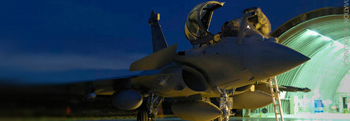

Interoperable with all major forces
The RAFALE has demonstrated its interoperability with numerous assets in the air, on ground and at sea: command and control centres, tactical air controllers, airborne sensors and other fighters - both U.S. and non-U.S.
The mission system is totally adaptable to future and currently in-design data links, with flexibility in mind to serve the needs and the orientations set forth by the nation’s leadership.
The RAFALE is slated to become eventually the sole type of combat Aircraft operated by the French Air Force and French Navy. As a result, with the programme totally secured by the French government's commitment for approximately 300 Aircraft, among which 180 are already on firm order, the RAFALE is in production and more than 100 Aircraft are now in service.
Everything that is necessary to maintain its combat relevance will be done.
Starting in 2013, the RAFALE “OMNIROLE” fighters will be delivered with the “Active Electronically Scanned Array” (AESA) RBE2 radar. They will also be fitted with a new missile launch detector and a “Front Sector Optronics” updated unit (FSO-IT), offering improved target detection and identification performance.
Meanwhile, engineering work is already being done to further extend the air-to-air and air-to-ground capabilities and the connectivity of the RAFALE well into the next decade.
The ongoing effort will ensure more robust detection, tracking and identification of emerging air-to-air threats, and increase the RAFALE’s survivability with new low observable modes and with the latest advances in electronic warfare systems.
Air-to-surface capabilities could benefit from assisted target recognition and enhanced sensor resolution, enabling the RAFALE to attack ever more elusive targets.
New materials could extend the life of engine components and the connectivity of the RAFALE will be further extended to keep it “plugged” into tomorrow’s integrated battlespace.








